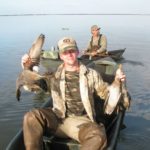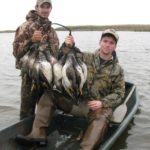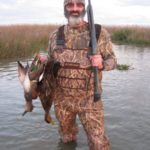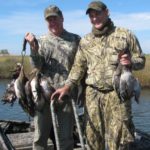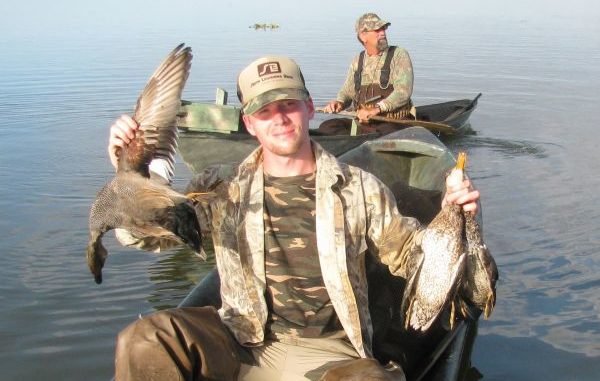
If you’re looking to get away from the crowds of duck hunters and still find plenty of gadwall for a full morning of shooting, then point your boat to the Biloxi Wildlife Management Area.
“Here it’s almost Christmas!” snorted Artie’s brud-in-law Anthony (pronounced: “Ant-Knee.”) “But for us it’s still TEAL season! That’s almost all we been gettin’ — and mostly bluewings to boot!”
“Why complain?” Pelayo laughed as he winked over at Doc Fontaine who, ever the gracious host, was tapping another keg. “Nothing wrong with teal — and that’s more than many other hunters in Southeast Louisiana are getting right now. Right, Doc? I know some people who are mostly scratching. They’d be delighted to be limiting out on teal right now. Right, Doc?”
“Yeah! Just like Ant-Knee!” Artie added. “Always gotta be complaining about something! Saints just creamed da Chicago Bears on a road game. Brees threw for 375 yaaawds! Saints now gotta chance for the play-offs! So Ant-Knee can’t moan and groan about Brees tonight. But he HAD to find something!”
Anthony seemed burned out on his traditional family lease near Caernarvon. He was shooting easy limits on easy hunts from a surface-drive boat-blind.
Then he got back to his Lakeview home almost in time for breakfast, practically mud-free, except for a little on his knee — not hip — boots.
But something seemed missing, or so he seemed to be telling us. It’s called hunting after all. He’d been mostly shooting.
“Almost like dove hunting,” he snickered about shooting his easy teal limits two to three times a week. “Man, we all grew up shooting greys! After calling them in! I miss that!”
“More like dos gris,” Artie reminded him with a chuckle. “After a crabber put ’em up and they zoomed into our decoys! We probably shot four or five dogs for every grey in ’dem Jim Mora days. Remember: Before the Ke-NAAAW-van diversion that entire Delacroix area was dos gris central!”
“Sure didn’t bother By Hek!’ Pelayo reminded us. “He loved ’em in a spicy brown gravy!”
“Come with us next week,” Pelayo offered. “I’m pretty sure we can show you some greys — and during a gen-you-wine hunt. Might bring back some memories. Heck, we might even get a dos gris or two!”
“Greys like widgeon grass,” Pelayo said in a professorial tone. “Sure, they’re quite fond of all that water milfoil and coontail clogging the bays in Southeast Louisiana marshes nowadays, and forming those thick mats in Lake Lery, Grand Lakes, etc. But gadwall are really attracted to widgeon grass, which grows better in brackish than in fresh marshes.”
“Yeah, that’s another thing!” Anthony interrupted. “When I hunt with my buddy on his lease outta Pointe La Hache, there might be plenty greys around but there ain’t no getting them over the dekes in our pond! No matter how many dekes or how hard you call! They all land in the middle of those big mats of grass way out in the open waaaw-dah! Dey got all the feed they need out there. No need to come into the ponds.”
“I know what you mean,” Artie laughed. “Heck, we might have to stop calling them ‘duck ponds’ nowadays. Instead, let’s call ’em redfish ponds. Ya un’erstan’ what I’m saying?!”
“Shoot!’ Doc added. “They’re forming huge grass mats all the way out to Bay Gardene! What used to be oyster beds!”
“Hook up with us for next weekend, “Pelayo taunted Anthony. “We got room, if you’re willing to put in a little woyk. Ain’t no surface drives like yours allowed in the Biloxi WMA. But we’ll be hunting in an area and in a manner — and shooting the type of ducks — that might take you back to the Bum Phillips, Jim Mora Saints era. Weatherman’s predicting a nice front; I can almost guarantee some of those greys you say you been missing so much.”
“I’m in!” Anthony yelled while high-fiving Pelayo.
Alas, ducks can be extremely nomadic in the vast, brackish Biloxi marsh. Sure, all ducks, regardless of habitat, respond to hunting pressure. But that’s not usually the issue in the relatively low-pressure Biloxi WMA.
Instead, it’s often those fickle water levels that send ducks scooting away from or swarming into certain regions from week to week — heck, from day to day.
Dabbling ducks (which include gadwalls) like it shallow, usually a foot or less of water. Here they can tip up to reach the seeds and favored widgeon grass on the bottom. In the Southeast Louisiana marshes, a 5-degree shift in the wind from north to just slightly northeast (or vice versa) can mean a 10-inch tidal change in two days.
An area crammed with greys and teal during your scouting trip might have two mergansers and three dos gris when you come back, with the high tides putting the widgeon grass out of beak range.
And these wind-driven tides are on top of the regular daily tidal ranges. I check Louisiana Sportsman’s tide guides as fanatically for duck hunting as for fishing.
But food never seemed like the primary attraction for ducks in the Biloxi marsh. Even in the “glory years,” grass beds in the Biloxi marsh ponds were sparse and scattered, with widgeon grass (more a brackish-water product) predominating instead of milfoil, coontail and smartweeds (more fresh-water products).
Remoteness and seclusion always seemed more like the Biloxi marsh’s attraction for ducks. It’s a nice little haul out here, especially to the Bayou Domingo/Goose Flat areas we like to hunt. But it’s worth the ride to avoid crowds and the always-attendant sky-busting among the other delights of hunting “easy-access” places like Manchac, Pearl River and Big Branch.
What a joke.
Rounding a sharp bend with Pelayo’s outboard cavitating horrendously as we neared Bayou Domingo, some ragged groups of ducks started lifting around us.
“Mostly greys,” Artie said, pointing as Anthony’s eyes lit up.
No CLOUDS of birds like we’d seen on “invite hunts” to Caernarvon and Welch earlier in the year, or even like the huge flocks we encounter on our Mississippi Delta hunts. But that’s exactly what made this a duck HUNT — in the most genuine sense of the term.
A good portion of those greys would filter back in singles, pairs and small groups all morning long.
By the time we parked the boat and started unloading the pirogues, it was almost 7:45 a.m. — when most duck hunters are picking-up their dekes.
You see, in our experience, this extreme edge of the Biloxi marsh gets flights later in the morning, either because these saltier ponds serve as resting areas or because of the pressure out west close to Lake Borgne.
Or because of both.
I was throwing out the decoys with Anthony and Artie while Pelayo fashioned an impromptu blind with palmetto leaves and a small bundle of fluffy bamboo we always bring along. We stick five palmettos in front and five in back of the 14-foot pirogue which serves as the base of our portable blind.
Then we erect a thin screen of bamboo to blend better with the marsh than does the palmetto.
We set out the bulk of the 32 decoys in a cove to the right of the blind — not directly in front.
Greys prefer to land in open water, away from the bank. With the wind at an angle from our backs, this would put any incoming ducks in front of us as they approached the decoys.
Just as we finished, I saw Pelayo pointing and scurrying for cover.
HAH! Four greys were closing in — probably among those we flushed earlier.
But we didn’t scurry fast enough, and they flared.
Then, just as Artie dragged the ’rogue behind the blind and we assembles ourselves on the bench in the “shooting ’rogue,” a pair of birds came in unannounced from the left.
Another six were right behind, cupped up beautifully with the sun, well over the horizon by now, shining off their white bellies.
Anthony nudged me.
“Teal!” he hissed, pointing with his chin as they decoyed.
“Pretty big teal,” Pelayo said as we rose, and shouldered the guns.
A wild flurry of furiously flapping wings filled the sky.
BLAM!
A big-headed gadwall drake crumpled to Pelayo’s first shot.
BLAM!
Another on my left, as Artie cut loose.
“Shu-wuck” went his pump — BLAM! — and yet another one crumpled.
BLAM!
Still another grey folded after a 30-yard going-away shot I finally squeezed off. It landed with a mighty splash and a puff of feathers.
Amazingly, a slow bird still lingered overhead, flapping hard against the wind for some reason — and the angle of its flight put it right overhead.
I swung and led the bird about a foot and hit the trigger.
BLAM!
I kept swinging the barrel, and the bird crumpled, missing us by 5 feet as it thumped on the spartina grass behind our position.
The whoops and high-fives started — until we spotted another flock banking in from the right and ducked.
We mouthed the calls for a few chuckles, for the mere principle of the thing. They were decoying regardless.
An absolutely glorious morning of duck HUNTING ensued. High-fives and the warm glow of rollicking success continued on the ride home.
And we had barely bagged half the four-man limit — mostly greys with a few dos gris, a teal and a mottled duck for old times’ sake.
